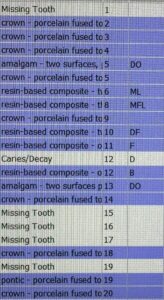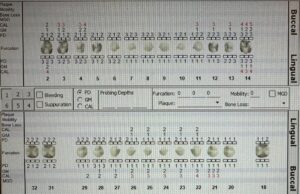Case Study #2 – Patient with Extensive Allergies, Medications, and Dental Restorations
The patient was a 76-year-old Caucasian female who presented to the clinic for a routine dental cleaning. During the initial visit, the patient informed us of her allergies to certain substances, including Listerine, peaches, thyme, melons, and treenuts. The patient reported experiencing hives, rashes, watery eyes, and a runny nose during allergic episodes. As a precaution, we have documented the patient’s allergies and have ensured that she will not be exposed to Listerine mouth rinse or the melon-flavored 5% NaF varnish during her treatment.
Furthermore, the patient has reported that her most recent medical examination was conducted on June 24th, 2022, by her gerontologist, and that she underwent a routine blood test in February 2022. By maintaining a comprehensive medical history, we can ensure that the patient receives safe and effective treatment.
Under the care of her Primary Healthcare Provider, the patient was currently taking:
- Hydralazine 25 mg TID – treats high blood pressure
- Metoprolol 25 mg OD – treats angina and hypertension
- Olmesartan 40 mg HS – angiotensin II receptor blocker that treats high blood pressure
- Hydrochlorothiazine 2.5 mg OD – treats edema (fluid retention)
- Gabapentin 400 mg OD – to treat partial seizures, nerve pain from shingles and restless leg syndrome
- Piroxicam 20 mg OD – NSAID used to treat pain or inflammation caused by osteoarthritis or rheumatoid arthritis
- Centrum OD – indicated for use to “help growth and good health”
- Magnesium Oxide 500 mg OD – as a supplement to maintain adequate magnesium in body
- Vitamin D 1000 IU OD – boosts low levels of Vitamin D in the body
- Calcium 600 mg + Vitamin D 400 IU OD – to treat low blood calcium levels
- Super Vit B’s OD – used to treat vitamin deficiency
- Fentanyl Patches 25 mcg y3d – used to relieve severe pain
- Meclizine 25 mg BID PRN – used to treat motion sickness and vertigo
At the time of the appointment, the patient’s blood pressure was measured to be 110/55 with a heart rate of 70 beats per minute. Given that the patient was taking medications for high blood pressure, which can result in orthostatic hypotension, it was necessary to position the patient more upright than would typically be required for patients without this condition.
Despite having extensive dental restorations and being diagnosed as a Stage III Grade B, the patient demonstrated excellent oral hygiene practices. She reported using a manual soft-bristle toothbrush with fluoride toothpaste and flossing at least once daily using floss picks or proxybrushes. In addition, the patient used Sodium Fluoride 1.1% Gel once daily, indicating a commitment to maintaining optimal oral health.
To accommodate the patient’s allergies, alternative options were provided for the final mouth rinse and fluoride application at the conclusion of her treatment. Specifically, the use of Listerine mouth rinse was replaced with plain water, while the melon-flavored 5% NaF varnish was substituted with 5% Neutral Fluoride foam administered via a tray system. These substitutions ensured the patient’s safety and comfort during her visit.







